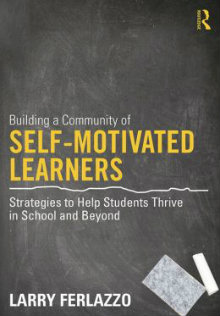Intrinsic Motivation Helps Learners Thrive
Building a Community of Self-Motivated Learners: Strategies to Help Students Thrive in School and Beyond
By Larry Ferlazzo
(Routledge, 2015 – Learn more)

This is the third book in Larry Ferlazzo’s series on motivating students and can be used either in conjunction with the other two books or on its own.
The first three chapters — I Still Want To Know: How Do You Motivate Students?, I Still Want To Know: How Can You Best Handle Classroom Management?, and I Still Want to Know: How Can You Get Students More Interested in Reading and Writing? — focus on the classroom conditions needed for motivation, especially intrinsic motivation. He notes that when students are motivated to learn: they perform better, behave better in class, and have better attendance and greater self-esteem.

As he does throughout the book, Ferlazzo provides numerous resources in his Immediate Actions section to address each of these elements and then spends considerable time providing step-by-step lessons for use in the classroom. Each lesson is tied to the Common Core Standards for Reading, Writing, Speaking and Listening, and Language, and includes either links to resources, such as his well-known “best” lists, or as figures, all of which are downloadable from the book’s eResources page.
More about what’s in the book
In chapters 1-3, Ferlazzo provides lessons on such topics as goal setting, grit, boredom, gratitude, poverty and the brain, reading and the brain, and the summer slide, and discusses why each of these is important to motivation.
In chapters 4-6, Ferlazzo addresses helping students transfer skills and knowledge to other classes and outside of school situations, helping students choose a physically healthy lifestyle and helping students take actions to get in the state of flow. The lessons in these chapters are designed to help our students take responsibility for their own learning through understanding and true intrinsic motivation.
Although he often refers to the lessons in his previous two books, he discusses how the lessons in this book can be used in conjunction with the two other books or can be used independently of them, as well as how the lessons can be referred to in other lessons, to tie all of these skills together as the underpinning of the classroom culture and help students to build on existing knowledge. Each lesson includes ideas for assessment and possible extensions/modifications, and each chapter is fully referenced.
All of the figures in the book (most of which can be used as student handouts as part of the lessons) are provided as eResources which can be downloaded, and numerous Ed Tech boxes give links to videos and other resources that can be used with the lessons provided or to expand upon them.
Building a Community of Self-Motivated Learners provides step-by-step lessons with the needed resources for teachers to teach some of the social emotional learning that has been shown to be vital to student success, and to increase student awareness to lead them to intrinsic motivation and ownership of their learning, both in the classroom and in the world.
Dr. Laura Von Staden is a Special Education Middle School Teacher in Tampa, Florida. She serves on numerous committees both at her school and within her district and works closely with the local university where she is a Professional Practice Partner and a master mentor. Dr. Von Staden also facilitates both online and face-to-face Professional Development for her school district.


































